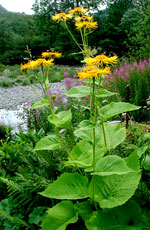Elecampane
Inula helenium
family:Asteraceae

the plant: a tall, downy broad-leafed perennial that can grow up to 6', with a branching stem of many yellow blossoms that look like mini sunflowers. Root is mucilaginous and orange in color fading to white in center. Prefers moist meadows & damp, rocky roadsides with plenty of sun, can propagate by dividing rootstock. Native to Southeastern Europe & Western asia, now naturalized in central & eastern US & Canada. 
parts used: root.
medicinal actions: expectorant, antitussive, antimicrobial, antispasmodic, carminative, tonic, hepatic, astringent, diaphoretic.
preparation: (ideally cold infused) warm root tea; tincture, medicinal honey, syrup.
indications: a bitter, spicy, aromatic and warming antimicrobial herb to dispel that cold, damp early-winter malaise. Elecampane = Lung, and has also been used since ancient times as food and medicine to stimulate digestion. it is best known today for its powerful abilities to warm, loosen, draw forth and relax chronic, cold, wet lung issues.
 Indicated for chronic bronchitis and pertussis, bronchial asthma, emphysema, tuberculosis - anything with chronic cold respiratory phlegm - as well as stagnant, cold digestion with bloating and gas.
Indicated for chronic bronchitis and pertussis, bronchial asthma, emphysema, tuberculosis - anything with chronic cold respiratory phlegm - as well as stagnant, cold digestion with bloating and gas.
It is a great remedy for children & the elederly, for chronic wet cough and catarrh, with antimicrobial traits to help combat the invading illness. A sweet & stimulating herb to reach for in the case of cold, slimy stagnation, whether it be in the lungs, the gut or (according to Pliny & ancient Ayurvedic healers) the spirit.
contraindications: not ideal with very hot, dry, irritated cough. May cause reactions in those allergic to the Asteraceae family.
note: This information is not a replacement for a trained herbalist. Please consult your medical professional before treating yourself or others with this or any other herbal remedy.